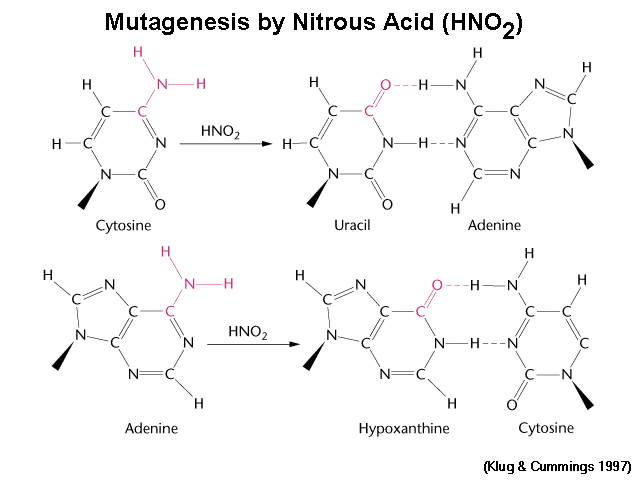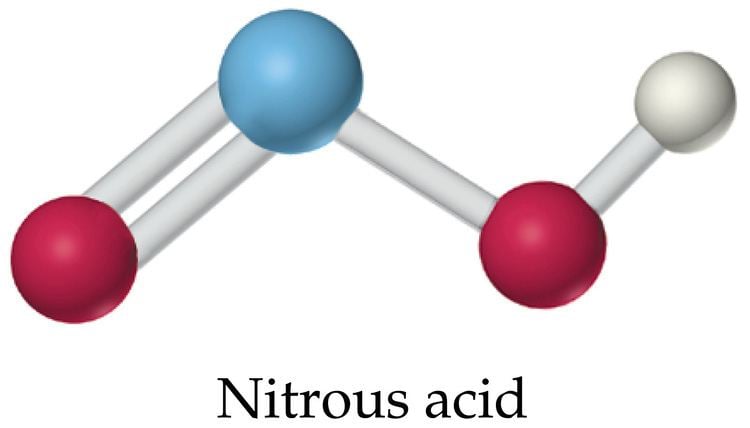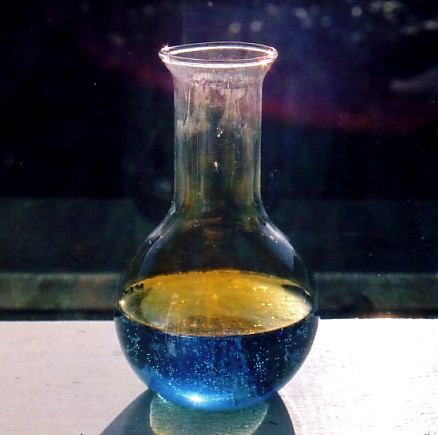3DMet B00022 Formula HNO2 Molar mass 47.013 g/mol Boiling point 158 °C | Related compounds IUPAC ID Nitrous acid Density 1 g/cm³ Appearance Pale blue solution | |
 | ||
Chemical properties of nitrous acid
Nitrous acid (molecular formula HNO2) is a weak and monobasic acid known only in solution and in the form of nitrite salts.
Contents
- Chemical properties of nitrous acid
- Preparation of nitrous acid
- Structure
- Preparation
- Decomposition
- Inorganic chemistry
- Organic chemistry
- Atmosphere of the Earth
- References

Nitrous acid is used to make diazides from amines; this occurs by nucleophilic attack of the amine onto the nitrite, reprotonation by the surrounding solvent, and double-elimination of water. The diazide can then be liberated to give a carbene or carbenoid.
Preparation of nitrous acid
Structure

In the gas phase, the planar nitrous acid molecule can adopt both a cis and a trans form. The trans form predominates at room temperature, and IR measurements indicate it is more stable by around 2.3 kJ mol−1.
Preparation

When cold, dilute solutions of nitrite ion, NO2− are carefully acidified, a light blue solution of nitrous acid is produced. Free nitrous acid is unstable and decomposes rapidly. It can be produced by dissolving dinitrogen trioxide in water according to the equation
N2O3 + H2O → 2 HNO2Decomposition
In anything other than very dilute, cold solutions, nitrous acid rapidly decomposes into nitrogen dioxide, nitric oxide, and water:
2 HNO2 → NO2 + NO + H2ONitrogen dioxide disproportionates into nitric acid and nitrous acid in aqueous solution:
2 NO2 + H2O → HNO3 + HNO2In warm or concentrated solutions, the overall reaction amounts to production of nitric acid, water, and nitric oxide:
3 HNO2 → HNO3 + 2 NO + H2OInorganic chemistry
Reduction of the acid gives different products, depending on the reducing agent:
With I− and Fe2+ ions, NO is formed:
2 KNO2 + 2 KI + 2 H2SO4 → I2 + 2 NO + 2 H2O + 2 K2SO42 KNO2 + 2 FeSO4 + 2 H2SO4 → Fe2(SO4)3 + 2 NO + 2 H2O + K2SO4With Sn2+ ions, N2O is formed:
2 KNO2 + 6 HCl + 2 SnCl2 → 2 SnCl4 + N2O + 3 H2O + 2 KClWith SO2 gas, NH2OH is formed:
2 KNO2 + 6 H2O + 4 SO2 → 3 H2SO4 + K2SO4 + 2 NH2OHWith Zn in alkali solution, NH3 is formed:
5 H2O + KNO2 + 3 Zn → NH3 + KOH + 3 Zn(OH)2With N2H5+, HN3, and subsequently, N2 gas is formed:
HNO2 + [N2H5]+ → HN3 + H2O + H3O+HNO2 + HN3 → N2O + N2 + H2OOxidation by nitrous acid has a kinetic control over thermodynamic control, this is best illustrated that dilute nitrous acid is able to oxidize I− to I2, but dilute nitric acid cannot.
I2 + 2 e− ⇌ 2 I− {Eo = +0.54 V}NO3− + 3 H+ + 2 e− ⇌ HNO2 + H2O {Eo = +0.93 V}HNO2 + H+ + e− ⇌ NO + H2O {Eo = +0.98 V}It can be seen that the values of Ecello for these reactions are similar, but nitric acid is a more powerful oxidizing agent. Base on the fact that dilute nitrous acid can oxidize iodide into iodine, it can be deduced that nitrous is a faster, rather than a more powerful, oxidizing agent than dilute nitric acid.
Organic chemistry
Nitrous acid is used to prepare diazonium salts:
HNO2 + ArNH2 + H+ → ArN2+ + 2 H2Owhere Ar is an aryl group.
Such salts are widely used in organic synthesis, e.g., for the Sandmeyer reaction and in the preparation azo dyes, brightly colored compounds that are the basis of a qualitative test for anilines. Nitrous acid is used to destroy toxic and potentially explosive sodium azide. For most purposes, nitrous acid is usually formed in situ by the action of mineral acid on sodium nitrite: It is mainly blue in colour
NaNO2 + HCl → HNO2 + NaCl2 NaN3 + 2 HNO2 → 3 N2 + 2 NO + 2 NaOHReaction with two α-hydrogen atoms in ketones creates oximes, which may be further oxidized to a carboxylic acid, or reduced to form amines. This process is used in the commercial production of adipic acid.
Nitrous acid reacts rapidly with aliphatic alcohols to produce alkyl nitrites, which are potent vasodilators:
(CH3)2CH-CH2-CH2-OH + HNO2 → (CH3)2CH-CH2-CH2-ONO + H2OAtmosphere of the Earth
Nitrous acid is involved in the ozone budget of the lower atmosphere: the troposphere. The heterogeneous reaction of nitric oxide (NO) and water produces nitrous acid. When this reaction takes place on the surface of atmospheric aerosols, the product readily photolyses to hydroxyl radicals.
